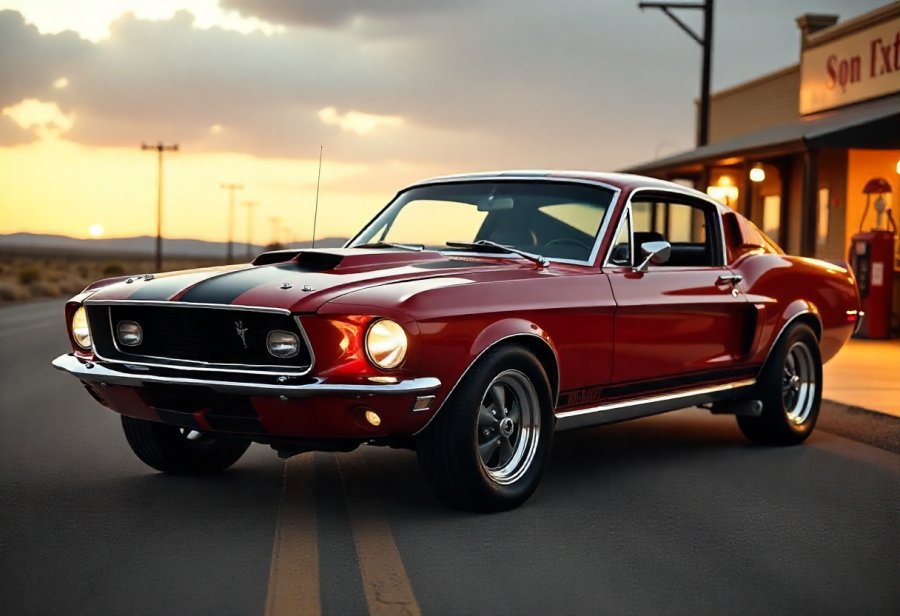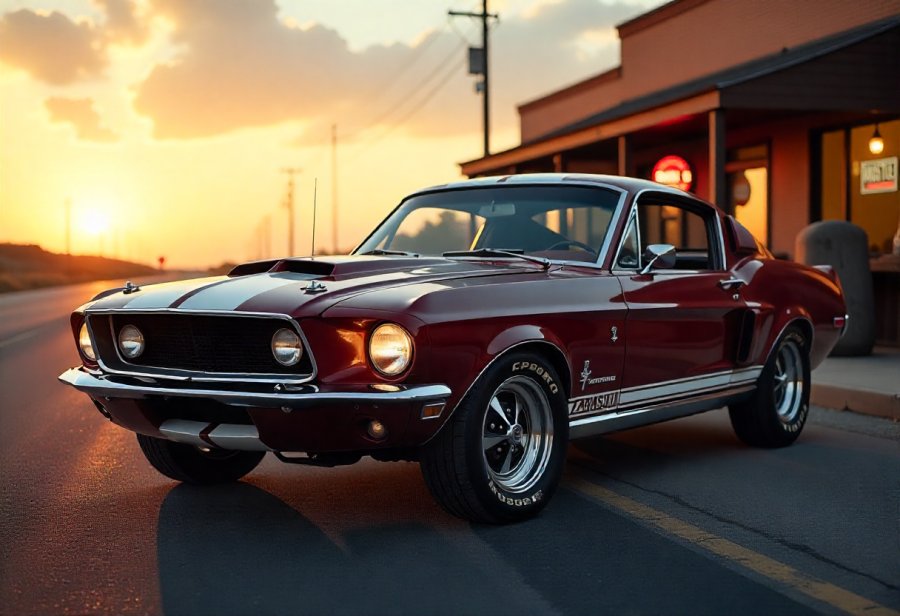The Ford Mustang stands as an enduring symbol of American freedom, rebellion, and innovation, captivating generations with its bold design and raw performance. But what is it that makes this legendary muscle car so timeless and universally appealing? From its revolutionary debut in 1964 to its continuous evolution, the Mustang has balanced tradition with modern technology, ensuring relevance across eras. It’s more than metal and horsepower; it embodies dreams of independence, adventure, and personal expression. Whether restoring a vintage model, customizing a modern masterpiece, or sharing stories within a passionate community, owners keep its legacy alive. As Ford pushes toward electrification, can the Mustang retain its rebellious soul while embracing the future? This iconic car’s story is not just about speed but about resilience, cultural influence, and the relentless pursuit of freedom—an ongoing journey that invites every driver to chase their own legend.

The Ford Mustang: An American Icon of Freedom and Innovation
The Ford Mustang is more than just a car; it’s an emblem of American freedom and innovation that has captivated drivers for nearly sixty years. When it first hit the market in 1964, the Mustang stood out with its bold design, sporty attitude, and accessible price—an invitation to embrace independence and adventure. It wasn’t simply a means of transportation; it was a statement that resonated with a generation eager to challenge conventions and carve out their own path.
What set the Mustang apart from other vehicles of its era was its revolutionary approach to style and performance. Its sleek, muscular lines, the iconic running horse emblem on the grille, and its aggressive stance gave it a commanding presence on the road. The fastback silhouette, with its flowing, aerodynamic shape, suggested speed even when parked. Combining eye-catching design with practicality, the Mustang offered a vehicle that looked fast and felt powerful—all at a price that many could afford. This winning formula created a new segment—the pony car—that continues to influence automotive design today.
Beyond its striking appearance, the Mustang became a symbol of rebellion and youthful energy during the 1960s. It resonated with a generation eager to break free from tradition and seek new experiences. Its powerful V8 engines and customizable options made it a favorite among both car enthusiasts and casual drivers. Films like “Bullitt” and “Gone in 60 Seconds” helped elevate its reputation as a car built for speed and excitement, while its presence in music and street culture cemented its status as a cultural icon. The Mustang embodied freedom, individuality, and the thrill of the open road.
The story of the Mustang didn’t end with its initial launch. Over the decades, it has evolved constantly—adapting to changing tastes, new technologies, and performance standards—while staying true to its core identity. Each generation has introduced innovations, from design tweaks to engineering upgrades, that keep the Mustang fresh and relevant. Despite these changes, the essence remains the same: powerful engines, aggressive styling, and that unmistakable American muscle spirit. This ongoing evolution has helped the Mustang maintain its legendary status, inspiring new drivers and enthusiasts alike.
Today, the Mustang continues to symbolize more than just a vehicle; it represents an enduring legacy of American creativity and resilience. It’s a car that has grown with its owners, embodying their dreams of freedom and achievement. Whether as a vintage classic or a modern performance machine, the Mustang’s story is woven into the fabric of American automotive history. It’s a timeless icon that invites everyone to chase their own adventures on the open road.
Tracing the Evolution of the Mustang: From Classic Roots to Modern Powerhouses
Since its debut in 1964, the Ford Mustang’s journey has been one of constant innovation and adaptation, reflecting shifting tastes, technological progress, and market demands. The original models established a high standard with their compact size, aggressive styling, and powerful V8 engines, quickly making the Mustang a symbol of American muscle. They created a new niche—the pony car segment—that combined sporty looks with affordability, making performance accessible to a broad audience.
As the decades passed, the Mustang faced changing automotive trends. The 1970s and 80s brought softer designs and smaller engines, driven by rising fuel prices and stricter emissions standards. Despite these shifts, Ford worked to preserve the car’s core appeal, introducing models like the Fox-body, which balanced performance with comfort and efficiency. This era was about maintaining relevance by blending sportiness with practicality, ensuring that the Mustang remained a desirable choice amid evolving consumer preferences.
The 2005 reintroduction marked a pivotal moment for the model. Ford paid homage to the original design with retro cues—long hood, short rear deck—while integrating modern technology and safety features. This move reignited enthusiasm among longtime fans and drew in a new generation of drivers. Under the hood, the latest V8 engines and improved handling restored the Mustang’s reputation for performance, blending nostalgia with cutting-edge innovation that kept its spirit alive.
In recent years, the Mustang has continued to push boundaries with turbocharged four-cylinder options, hybrid variants, and advanced driver-assist features. These updates reflect a broader industry shift toward efficiency and connectivity without sacrificing power or attitude. Lightweight materials, improved aerodynamics, and sophisticated suspensions help the Mustang perform well on both street and track, maintaining its edge in today’s competitive automotive landscape.
Throughout its evolution, the Mustang has managed to stay true to its roots—muscular engines, aggressive design, and a rebellious spirit—while embracing new technologies. This ability to adapt without losing its core identity has kept it relevant and beloved across generations. Whether vintage or modern, each iteration adds a new chapter to the ongoing legacy of a car that’s as much about attitude as engineering.
The journey of the Mustang highlights its resilience and relevance. It’s a testament to Ford’s commitment to innovation, with each new model building on the last. By balancing tradition with progress, the Mustang continues to inspire drivers and enthusiasts worldwide, ensuring its place as an enduring icon of American muscle and performance.

The Mustang Legacy: A Symbol of American Resilience and Rebellion
The Ford Mustang’s legacy extends far beyond its debut, shaping the very essence of American muscle cars and leaving an indelible mark on automotive history. Its distinctive combination of raw power, striking design, and cultural presence set a new standard for performance cars and elevated the idea of an accessible, stylish vehicle for the masses. Over the decades, the Mustang has become more than just a car; it’s a symbol of American innovation, rebellion, and freedom that continues to resonate with enthusiasts worldwide.
What truly makes the Mustang’s legacy enduring is its ability to evolve while remaining rooted in its original spirit. Each generation has built upon the foundations of the first models, blending modern technology, safety features, and performance upgrades without losing the aggressive stance and rebellious attitude that made it famous. This seamless balance of tradition and progress ensures that the Mustang stays relevant, inspiring new drivers and dedicated fans alike.
The Mustang’s role in establishing the American muscle car movement is undeniable. Its introduction sparked a wave of innovation among automakers, pushing boundaries in performance, affordability, and style. Its appearances in iconic films like “Bullitt” and “Ford v Ferrari,” along with its prominence in pop culture, cemented its legendary status. More than a vehicle, it became an emblem of freedom, speed, and the pursuit of adventure—values that continue to define the American spirit.
Culturally, the Mustang fosters a deep emotional connection. Owners see it as a vessel for personal stories—whether restoring a vintage model or customizing a modern one. These cars often symbolize milestones, personal transformation, and shared passion. The stories of owners passing down their love for the car across generations help keep the Mustang’s legacy alive, turning it into a living history of dreams, effort, and achievement.
Today, the Mustang’s relevance persists through adaptation. Ford’s move toward electric and hybrid models demonstrates a commitment to innovation, ensuring the car’s performance and rebellious DNA remain intact amid environmental shifts. This ability to honor its heritage while embracing the future keeps the Mustang at the forefront of automotive culture, inspiring new generations to chase their own dreams on four wheels.
At its core, the Mustang remains a symbol of American resilience and ingenuity. Its legacy is built on emotional resonance, cultural influence, and a relentless drive forward. As it continues to evolve, it does so with the same spirit that made it a legend—unapologetically bold, fiercely independent, and forever iconic. The Mustang’s story is far from over, but its place as an enduring American icon is already secured.
For those interested in exploring the full history and significance of this iconic vehicle, a comprehensive overview can be found at Ford Mustang’s official site. Understanding its evolution offers valuable insight into how the Mustang continues to inspire automotive innovation and cultural pride, ensuring its legacy endures for generations to come.
Living the Legend: Personal Stories of Freedom and Passion with the Mustang
For many Mustang owners, the car becomes more than just a mode of transportation; it transforms into a personal symbol of freedom and achievement. Take the story of a vintage 1967 Fastback, painstakingly restored over months of dedication. Every detail, from engine upgrades to interior finishes, reflects a deep connection to the past. Restoring such a classic isn’t just about craftsmanship—it’s about reviving a piece of automotive history and creating a tangible link to the legacy that makes the Mustang special.
Driving a Mustang often sparks a sense of exhilaration and independence that sticks with owners long after they hit the road. Many recall their first drive in a vintage model—the rumble of the V8 engine, the wind in their hair, and the open highway ahead. These moments aren’t just about speed; they’re about feeling in control, embracing adventure, and living out a piece of the car’s rebellious spirit. For enthusiasts, every journey is a reminder of why the Mustang has become an icon of freedom.
The stories extend across generations, often passed down through families. A father teaching his son to work on a restored Mustang not only imparts skills but also forges a bond rooted in shared passion. These collaborations turn into lifelong memories, keeping the Mustang’s story alive and vibrant. For many owners, the car is a vessel of tradition—a way to connect with loved ones and introduce new generations to the thrill of American muscle.
Different models add layers to this experience. Whether it’s a classic GT, a Shelby, or a limited-edition Bullitt, each Mustang has its own story and personality. Personalization—adding racing stripes, custom wheels, or performance upgrades—lets owners craft a unique expression of their identity. These modifications aren’t just aesthetic; they deepen the emotional connection and continue the legacy of individual passion within the broader Mustang narrative.
Being part of the Mustang community amplifies this sense of living the legend. Local clubs, online forums, and car shows create spaces for enthusiasts to share stories, swap tips, and celebrate milestones. Participating in these gatherings keeps the passion alive, ensuring the Mustang’s cultural influence endures. Whether showing off a freshly restored vintage or a modern powerhouse, owners become custodians of a tradition that inspires pride and camaraderie.
Owning a Mustang often means more than just the car itself. It’s about the stories of personal transformation, the thrill of the drive, and the legacy passed from one generation to the next. Each owner plays a role in keeping the Mustang’s spirit alive—whether through restoration, customization, or sharing their experiences. The car becomes a living testament to dreams realized and adventures yet to come.
In the end, living the Mustang legend is about embracing a lifestyle rooted in freedom, performance, and individuality. It’s about the roar of the engine, the open road, and the memories made along the way. Every Mustang owner contributes to this ongoing story, ensuring that the car’s timeless appeal continues to inspire, excite, and define the American muscle car legacy for generations to come.

The Enduring Legend: Why the Mustang Continues to Embody American Spirit and Innovation
The Ford Mustang’s status as a symbol of American freedom and innovation isn’t just rooted in its powerful engines or striking design; it’s embedded in its ability to embody the spirit of resilience and independence that defines the American character. From its debut, the Mustang challenged conventions by making performance and style accessible, turning speed into a democratized experience for a broad audience. This legacy of breaking barriers continues to resonate, reinforcing its position as an icon of American ingenuity.
What keeps the Mustang relevant across generations is its seamless blend of tradition and progress. Each new model pays homage to the original’s rebellious attitude while integrating modern technology, safety, and performance enhancements. This balance allows the Mustang to evolve without losing its core identity—aggressive, bold, and free-spirited. It’s this constant adaptation that ensures the car remains a symbol of pushing boundaries and embracing change.
Beyond engineering, the Mustang’s cultural influence elevates it to legendary status. Its appearances in iconic films and music, along with its presence on streets and in car culture, evoke a sense of adventure and possibility. Every roar of its engine and every silhouette sparks a desire to pursue dreams and live life on one’s own terms. The car’s widespread recognition and emotional pull turn it into more than transportation—it becomes a vessel for aspiration.
Owners see the Mustang as more than just a vehicle; it’s a personal emblem of achievement and independence. Restoring a vintage model or customizing a modern one reflects a passion for craftsmanship and a desire to keep the legacy alive. Each car, whether a classic or a modern masterpiece, tells a story of individual identity and shared pride, reinforcing the car’s role as a cultural touchstone.
The Mustang’s resilience lies in its ability to inspire pride and foster community. Car clubs, events, and shared stories create a sense of belonging among enthusiasts who see themselves as custodians of a tradition rooted in freedom and innovation. This community keeps the spirit of the Mustang alive, passing it down through generations and across borders.
As the automotive world moves toward sustainability, the Mustang’s legacy adapts without losing its rebellious soul. Ford’s investments in electric and hybrid models demonstrate a commitment to innovation that respects the car’s DNA—powerful, daring, and free. This balance between honoring history and embracing the future ensures the Mustang remains a symbol of resilience and ingenuity.
The enduring appeal of the Mustang is a testament to its status as a true American icon. It continues to inspire new drivers to chase adventure and express their individuality. Its story is one of constant evolution, yet it remains firmly anchored in the values of independence, resilience, and innovation. The Mustang’s legacy isn’t just about the past—it’s a promise of what’s yet to come, forever fueling the drive for freedom on four wheels.










